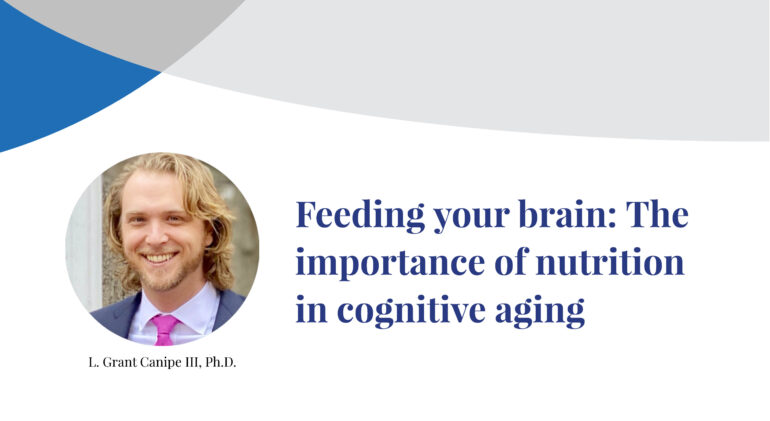As a Ph.D. scholar attempting to occupy a unique position connecting cognitive psychology, neuroscience, and public health to clinical practice, I am often asked, “What can we do to support our brains?”
Our lives are comprised of many different dimensions. Not surprisingly, many tie into brain health. To keep our brains healthy, we must ensure healthy social lives, we must attend to our emotional health (not holding onto negativity and minimizing stress), and we must maintain our cognitive health by continually challenging our brains.
If you don’t take care of your body, your social, emotional, and cognitive health will suffer. Exercise is important of course, but you must also attend to your nutritional health. Nutrition fuels the body and the brain. You are guaranteed a better life if you keep all these pieces in optimal shape.
Good nutrition is critical to your ability to optimize all of these, and it’s the reason for my research. We need to eat well.
If you have never thought of nutrition as important to brain function, consider this: If you own a fancy sports car, would you put bad gas in it or let it run out of oil? Of course not. Why, then, when gifted with a marvelous brain, do people fuel themselves with nasty, non-nutritional foods? Hopefully, current healthy trends in the U.S. will continue to develop.
There is a theory that aging is in part a by-product of normal metabolism. Approximately 3% of the cell’s oxygen atoms become reactive oxygen species (ROS). ROS oxidize and cause damage. How? ROS are a type of free radical, a chemical compound missing an electron. Without it, they scavenge cells for electrons and steal them, causing damage to proteins, lipids, and nucleic acids in our cells, potentially altering the function of a cell or rendering it useless. In the brain, oxidation increases cell death and inflammation, exacerbating the effects of cognitive aging.
In the body, sources of free radicals include aerobic respiration, slow metabolism, and inflammation. Our environment frequently increases the risk with pollution, sunlight, smoking, alcohol consumption, and even X-rays producing free radicals.
With free radicals being so prevalent and ROS being a by-product of well, living, what can we do to stop them?
Luckily, we have antioxidants. Antioxidants have an extra electron and can easily share. They reverse oxidation by neutralizing damaging free radicals. Research has shown diets high in antioxidants lower the risk cancer, heart disease, stroke, cataracts, Parkinson’s disease, Alzheimer’s disease, and arthritis.
You can find antioxidants in fruits and vegetables. These contain, for example, vitamin C and E, beta-carotene, and selenium which all work as antioxidants. Consuming enough antioxidant foods will overpower free radicals, supporting overall health.
Thus, the prescription is: Eat more fruits and vegetables. However, you may want some specifics. The easiest method I have found is to eat a rainbow of foods. That’s it. Each color indicates a different bioactive ingredient needed in your body. Now we move to the discussion of how nutrients are delivered to your brain and a few specific nutrients’ function.
First, how do we get those nutrients from the stomach to the brain? Your bloodstream does that, so it follows we need to ensure the circulatory system is up and running well. You have probably heard one should consume good fats to improve cardiovascular health. Fatty acids found in fish oil are important for cardiac and brain function and vital for building a baby’s brain. In older women and men, they support the vasculature system and brain.
DHA has a role in cognitive abilities. It improves the ability of the neurons to move information from one to the next, so speed of processing, working memory, and long-term memory can all be helped by DHA. DHA can be found in eggs, meat from grass-fed animals, oily fish, and many supplemented foods in the US. Two to three servings of these DHA-rich foods per week is considered plenty.
You have probably heard about folate in relation to pregnancy, to ensure babies have a properly developed central nervous system. However, all women with a menstrual cycle need folate for individual needs as a folate deficiency will disrupt cognitive abilities. In older adults, it can help with osteoporosis and dementia. Folate can be found in all leafy greens, black-eyed peas, beans, and many other vegetables and fruits. Adults should eat 1 cup of spinach and 3 ounces of beef. Pregnant women should get double.
Zinc is not a nutrient discussed much, but it is important for gene support and regulating glucose. As we age, our senses are not as sharp anymore, and zinc supports smell and taste. And, of course, it helps fight off viruses. The recommended daily dosage is typically two to three servings daily. If you’re catching a cold, you may want to increase your intake.
Finally, catechins such those found in green tea – green tea contains antioxidants that will protect all the easily oxidized nutrients — regulate the stress hormone cortisol, support cardiovascular health, and possibly even prevent Alzheimer’s.
So what is our main conclusion? Aging can be helped and maybe even ameliorated with good nutrition.

